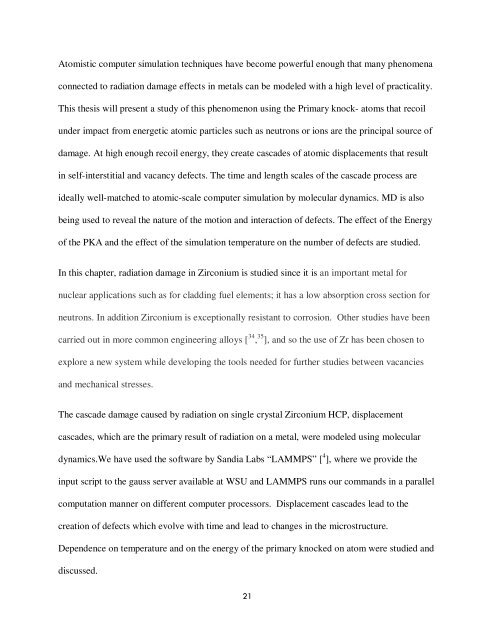DEFECTS IN METALS AND SIMULATION OF MECHANICAL ...
DEFECTS IN METALS AND SIMULATION OF MECHANICAL ...
DEFECTS IN METALS AND SIMULATION OF MECHANICAL ...
You also want an ePaper? Increase the reach of your titles
YUMPU automatically turns print PDFs into web optimized ePapers that Google loves.
Atomistic computer simulation techniques have become powerful enough that many phenomena<br />
connected to radiation damage effects in metals can be modeled with a high level of practicality.<br />
This thesis will present a study of this phenomenon using the Primary knock- atoms that recoil<br />
under impact from energetic atomic particles such as neutrons or ions are the principal source of<br />
damage. At high enough recoil energy, they create cascades of atomic displacements that result<br />
in self-interstitial and vacancy defects. The time and length scales of the cascade process are<br />
ideally well-matched to atomic-scale computer simulation by molecular dynamics. MD is also<br />
being used to reveal the nature of the motion and interaction of defects. The effect of the Energy<br />
of the PKA and the effect of the simulation temperature on the number of defects are studied.<br />
In this chapter, radiation damage in Zirconium is studied since it is an important metal for<br />
nuclear applications such as for cladding fuel elements; it has a low absorption cross section for<br />
neutrons. In addition Zirconium is exceptionally resistant to corrosion. Other studies have been<br />
carried out in more common engineering alloys [ 34 , 35 ], and so the use of Zr has been chosen to<br />
explore a new system while developing the tools needed for further studies between vacancies<br />
and mechanical stresses.<br />
The cascade damage caused by radiation on single crystal Zirconium HCP, displacement<br />
cascades, which are the primary result of radiation on a metal, were modeled using molecular<br />
dynamics.We have used the software by Sandia Labs “LAMMPS” [ 4 ], where we provide the<br />
input script to the gauss server available at WSU and LAMMPS runs our commands in a parallel<br />
computation manner on different computer processors. Displacement cascades lead to the<br />
creation of defects which evolve with time and lead to changes in the microstructure.<br />
Dependence on temperature and on the energy of the primary knocked on atom were studied and<br />
discussed.<br />
21

















